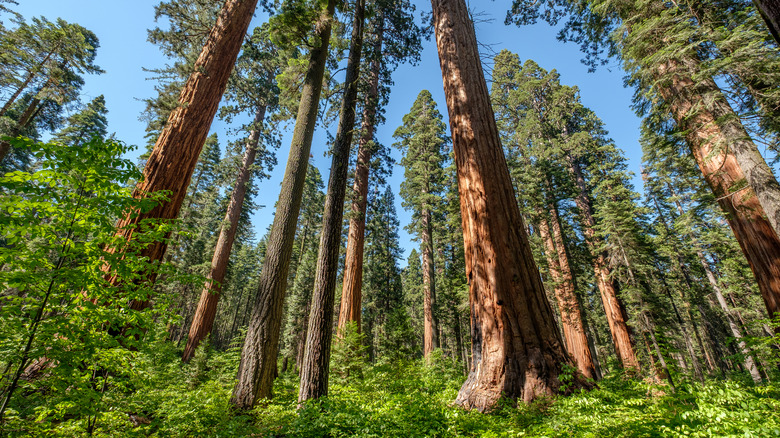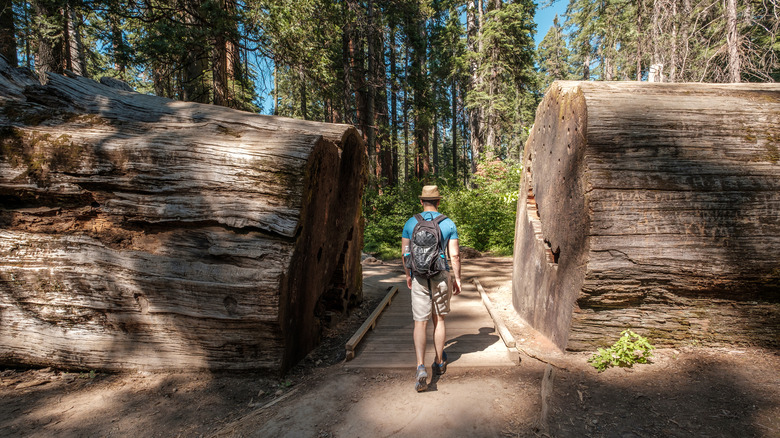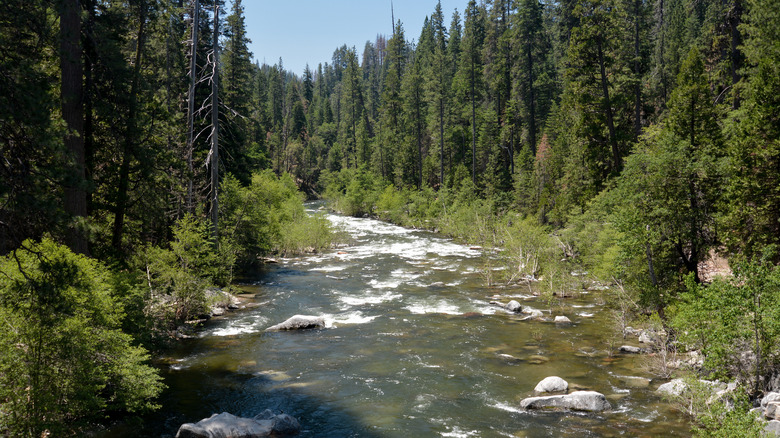California's Underrated Sequoia Tree State Park Hides In The Sierra Nevada Mountains To Swim, Camp, And Hike
Glimpsing a giant sequoia has to be one of the first things on a California bucket list. These colossal trees can grow to 300 feet tall and weigh more than 640 tons. Add to that the fact that they stand only in one of the Golden State's most alluring corners, lining the western edge of the iconic Sierra Nevada. You can spot them on the winding and breathtaking Kings Canyon Scenic Byway or tread beneath them in the ancient groves of legendary Yosemite National Park. You could also explore the lesser-known Calaveras Big Trees State Park.
The clue is in the name. The state-managed preserve holds not one, but two great stands of sequoias, which together number more than 1,000 specimens of the tree species. Naturally, they're the headline act, but there's a whole load more to boot — think gurgling rivers fed by mountain snowmelt, wildflower meadows that burst to life in the spring and summer, and campgrounds set deep within the forests.
Calaveras Big Trees State Park straddles the Ebbetts Pass Scenic Byway, a snaking route that crosses the Sierra Nevada from west to east. That byway is often closed to through traffic in the winter months, but only farther up the route from Calaveras, at Lake Alpine. That means accessing the state park from the western side of the Sierra Nevada is a safer bet. Expect a drive time of about 30 minutes from California's adventure-filled Gold Country, and just a touch over two hours from the Sacramento International Airport.
Hiking at Calaveras Big Trees State Park
Hiking paths wind through both groves of sequoias at Calaveras Big Trees State Park. The North Grove is smaller and looped by an easygoing, wheelchair-accessible trail of 1.6 miles. This is the grove that most folks come to see. The reason? It's the home of the stump of the so-called Discovery Tree, which was among the first mighty sequoias to draw crowds to these mountains back in the 1800s. The walk will take you right past the massive stump, through forests of dogwood trees dotted with curious spring flowers, and eventually to another host of soaring sequoias.
The Calaveras South Grove Trail is longer, 5 miles in all. Its grand finale is the behemoth that is the Agassiz Tree, the largest sequoia in the entire state park, which measures 250 feet in height and 25 feet in diameter! One past hiker summed up their encounter on Tripadvisor: "It is an amazing feeling walking among those giants near the Agassiz tree. ... It is a very humbling experience."
And once you're done being humbled by the monumental flora, there are plenty of other tempting paths. Spring is the perfect time to hit the Meadow Walk, a raised path that crosses fields of flowers that attract bees and butterflies. Or there's the 2.5-mile loop to Lava Bluffs, which reveals ancient volcano fields deep in the manzanita woods nearby.
Sleeping and swimming at Calaveras Big Trees
Those who want to linger a little in the presence of the majestic Sierra sequoias can do so thanks to the Calaveras Big Trees campground. It's an enchanting place to put up a tent. You'll sleep beneath centuries-old sequoias, smell the forest undergrowth first thing in the morning, and have all the hiking paths you want right at your doorstep.
Visitors can choose between two camping spots: The North Grove Campground, which is more accessible and closer to the main visitor center, or the Oak Hollow Campground, which sits deeper into the reserve and features pine and oak trees all around. All campsites come with fire pits, tables, and bear boxes. What's more, you can expect the sites to be a whole lot less busy here than they are in, say, Yosemite — Calaveras Big Trees gets just 200,000 visitors each year compared to Yosemite's four million (no wonder there's a lottery system to climb Half Dome these days).
The campgrounds do offer coin-operated showers, but there's a wilder way to freshen up near the North Grove of Calaveras. There, the Stanislaus River swings by a clutch of picnic tables and makes for a great summer swimming hole. You'll also find a spot to take a dip along Beaver Creek, amid big granite rocks that are millions of years old.


